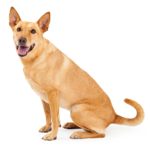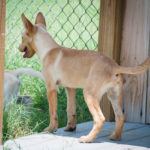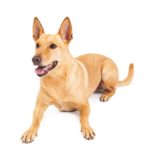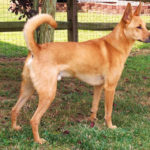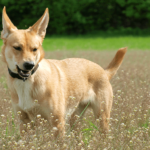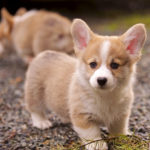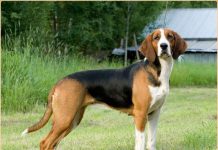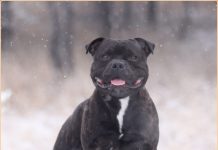The Carolina dog had existed as an original landrace dog for many years during the prehistoric era. However, it lost is natural landrace state following an era of continued migration into wild areas.
Most of the dogs of this breed had migrated into the wild and assumed a wild nature or free roaming status. It was only until the 1920s that the Carolina dog breeds got rediscovered by Dr Brisbin. Prior to this period, the dogs had almost been erased from the memories of most people.
But, continued research and interest from a number of scholars and dog breed enthusiasts led to recent resurgence of the breed. Today, a lot of facts about the breeds are already available even though several more are yet to be revealed. The following is a critical discussion of these dogs.
Carolina Dog Facts and Information
- They are generally difficult to train
- They are perfect watch dogs
- They possess medium energy levels
- Not good for homes with small animals; they pounce on non-canine animals
- They are not a hypoallergenic breed
- Their litter size ranges between 3 and 6 puppies
- They have a height ranging between 17.75 and 19.5 inches
- They have a strong desire for socialization
- Not compatible with other dogs; often show signs of indifference
- Puppy Price: Average $1200-$2000 USD
Diet
Food formula is often perfect for these dogs especially that which is required to keep a dog active. Additional supplements along with water must be given. This is primarily because they require a lot of energy to stay active.
Habitat
Carolina dogs often lived in the wild until the mid-20th century when they were rediscovered by Dr Brisbin. However, there are still some dogs of this breed that can be found in the wild.
In such circumstances, they live in sparsely populated areas, particularly settled land. For example, they enjoy wooded areas of which Metro Atlanta is one of them. Due to their love for digging sandy holes, they often reside in areas that are sandy coupled with some shed.
The females are often the ones that dig such holes for purposes of shielding their young against the effects of the heat or cold. This is especially the case if the females have just delivered or while they are still pregnant.
Lifestyle
These dogs enjoy sparsely populated habitats. This is what distinguishes them from most dogs that enjoy living in the wild. They often enjoy hunting for small animals such as mice and shrews. Therefore, are useful as hunter dogs. They are also great runners. Female dogs of this breed enjoy digging multiple tiny holes.
Lifecycle
Starts with mating, followed by pregnancy and delivery depending on whether there is a prevailing breeding season or not.
Predators
They may be preyed upon by wild cats and dogs such as wolves and lions depending on the area they are in.
Breeding
Breeding for the dogs is seasonal. They are usually sensitive to a number of external factors especially the onset of seasonal diseases. Their reproductive cycles follow three estrus cycles which are separated by short time frames. Many puppies are available in each of the breeding seasons.
Appearance
Carolina dogs are generally medium sized and come in a variety of shades particularly red ringer, black, buff and fawn. They may sometimes be tan, piebald and black. They may feature white markings on their chest, toes or tail tip that are small in size. Their puppies may have a mask which appears melanistic, but it often fades away following the coming of the adult coat.
These dogs have a primitive appearance, with a tail that often appears lighter than the rest of the body. Their heads are quite wide in appearance (like a wide triangle), featuring a muzzle that is tapered with expressed masculine jaw muscles. They have clearly visible ribs even when they are healthy, although this is not always the case. Black noses often characterize most of these dogs. Their females are more built than the males although they both possess a highly masculine body.
Life Span
The lifespan of these dogs ranges between 12 and 15 years, although it may a bit less than 12 years in the worst of living conditions.
Carolina Dog Health Issues & History
Even though the Carolina dogs were naturally landrace, they eventually became wild dogs as time progressed. Although the specific reasons for this development are not known, it may be suggested that migration contributed to change in the landrace nature of the breed. This is further qualified by the research that was carried out by scholars such as Glover Allen of the department of Comparative Zoology at Harvard College.
According to the revelations of the research, the dogs originated from Asia and carried to inhabited locations across the globe by individuals who had migrated from Asia. Information revealed by archeological studies of the skeletal remains of the dogs which were discovered in the late 19th century show that the same dogs were found in India following the excavation of Indian mounds. In 1893, Cope was able to describe the appearance of the jaws of the breed after studying a specimen which was found in the state of Florida.
Due to the close resemblance of these dogs with the dingo, they are often said to be American Dingos or Dixie Dingos. As a matter of fact, they are commonly referred to as dingos in the US in which case they can be considered as natives of the US.
Carolina dogs may have a number of health issues, but the most notable one is heartworm which is often seasonal. Since this condition also affects their young, they usually protect their young by giving birth during episodes when the disease is absent. They may also have cataracts and cancer depending on the living conditions they are subjected to.
Images, Pics, Photos and Pictures Of Carolina Dog :
Grooming
Not much grooming is required when keeping these dogs. But, the use of a brush once a week or every ten days is a perfect idea.
Shedding
Shedding for these dogs is quite important and often occurs twice a year. Intermediate shedding episodes may be observed depending on the season.
Temperament and Personality
They have a primitive temperament which is generally softer than most of the other primitive dogs known today. They prefer company of their own to strangers, unless they are given proper planning. The breed also displays a suspicious and nervous behavior when around strangers. They may form strong bonds with other dogs and any canine animal. Further, a lot of extra effort is required to train these dogs.
Carolina Dog Characteristics
- Not very prone to genetic disorders
- Have a weight ranging between 30 and 44 lbs
- Short and ginger colored coat
- Enjoy sparsely populated habitats
- Highly developed hunting instincts
- Shy around humans unless after frequent exposure


